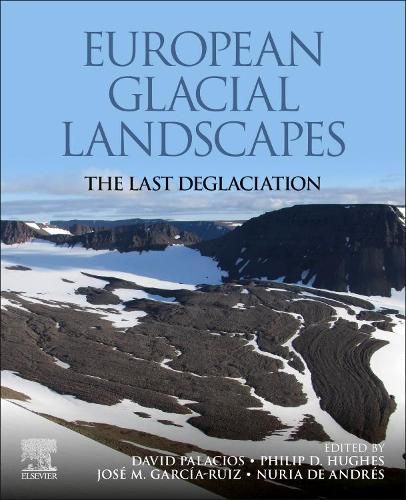Readings Newsletter
Become a Readings Member to make your shopping experience even easier.
Sign in or sign up for free!
You’re not far away from qualifying for FREE standard shipping within Australia
You’ve qualified for FREE standard shipping within Australia
The cart is loading…






European Glacial Landscapes: The Role of Glaciers in Shaping the Landscape of Europe During the Last Deglaciation brings together relevant experts on the history of glaciers and their impact on the landscape of the main European regions. The European glaciers ended their maximum expansion of the Last Glacial Cycleapproximately 20,000 years ago, when ice-sheets covered all the Scandinavian countries, Finland, much of the British Isles, the shores of the Baltic Sea and Central-Europe until roughly the present Rhine River. The glaciers covered also large areas of the main European mountains, such as the Urals, the Carpathians, the Alps, the Balkans, the Pyrenees, etc. Glaciers were also present even in the southernmost mountains, sometimes forming remarkable ice caps with cirque glaciers on relatively low mountains bordering the Mediterranean Sea. Soon after the Last Glacial Maximum from around 20,000 years ago a rapid process of glacial retreat began throughout Europe, which was interrupted several times by abrupt cooling of the climate, which caused rapid, though limited, re-advance of the glaciers, until the beginning of the Holocene, 11,700 years ago when climate became relatively stable and warm. These successive glacial advances and retreats during the Last Deglaciation have shaped much of the European landscape, reflecting abrupt climatic fluctuations. The Last deglaciation is especially important for the landscape of Europe because the evidence is so well-preserved since it records the most recent evidence of the Pleistocene ice age. In recent decades, research on the origin and age of the resulting glacial landforms has greatly improved in many regions of Europe. In addition, the evolution of the climate is becoming better known through detailed analysis of lacustrine and marine sediments, and Greenland ice cores.
As our knowledge on abrupt climate changes since the Last Glacial Maximum progresses, new uncertainties arise that are critical for understanding (i) the influence of atmospheric and oceanic currents on palaeoclimates and their spatial representation; (ii) the existence of asynchronies in the timing of occurrence of ice masses expansion and shrinkage; (iii) the time lags between oceanic and atmospheric changes, on one hand, and changes in precipitation and temperature patterns, on the other; (iv) the way in which climate changes disseminate through Europe and, consequently, the lag between climate changes and the expansion or contraction of glaciers; (v) the role of the large continental ice-sheets on the European climate, and particularly on the response of mountain glaciers, with special reference to the Mediterranean mountains. All these contributions are included in this book, in which the reader will find a complete review organized according to the main climatic periods of the so-called Termination 1 the important Late Pleistocene-Holocene transition.
$9.00 standard shipping within Australia
FREE standard shipping within Australia for orders over $100.00
Express & International shipping calculated at checkout
European Glacial Landscapes: The Role of Glaciers in Shaping the Landscape of Europe During the Last Deglaciation brings together relevant experts on the history of glaciers and their impact on the landscape of the main European regions. The European glaciers ended their maximum expansion of the Last Glacial Cycleapproximately 20,000 years ago, when ice-sheets covered all the Scandinavian countries, Finland, much of the British Isles, the shores of the Baltic Sea and Central-Europe until roughly the present Rhine River. The glaciers covered also large areas of the main European mountains, such as the Urals, the Carpathians, the Alps, the Balkans, the Pyrenees, etc. Glaciers were also present even in the southernmost mountains, sometimes forming remarkable ice caps with cirque glaciers on relatively low mountains bordering the Mediterranean Sea. Soon after the Last Glacial Maximum from around 20,000 years ago a rapid process of glacial retreat began throughout Europe, which was interrupted several times by abrupt cooling of the climate, which caused rapid, though limited, re-advance of the glaciers, until the beginning of the Holocene, 11,700 years ago when climate became relatively stable and warm. These successive glacial advances and retreats during the Last Deglaciation have shaped much of the European landscape, reflecting abrupt climatic fluctuations. The Last deglaciation is especially important for the landscape of Europe because the evidence is so well-preserved since it records the most recent evidence of the Pleistocene ice age. In recent decades, research on the origin and age of the resulting glacial landforms has greatly improved in many regions of Europe. In addition, the evolution of the climate is becoming better known through detailed analysis of lacustrine and marine sediments, and Greenland ice cores.
As our knowledge on abrupt climate changes since the Last Glacial Maximum progresses, new uncertainties arise that are critical for understanding (i) the influence of atmospheric and oceanic currents on palaeoclimates and their spatial representation; (ii) the existence of asynchronies in the timing of occurrence of ice masses expansion and shrinkage; (iii) the time lags between oceanic and atmospheric changes, on one hand, and changes in precipitation and temperature patterns, on the other; (iv) the way in which climate changes disseminate through Europe and, consequently, the lag between climate changes and the expansion or contraction of glaciers; (v) the role of the large continental ice-sheets on the European climate, and particularly on the response of mountain glaciers, with special reference to the Mediterranean mountains. All these contributions are included in this book, in which the reader will find a complete review organized according to the main climatic periods of the so-called Termination 1 the important Late Pleistocene-Holocene transition.